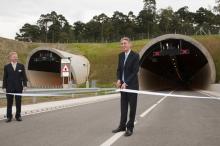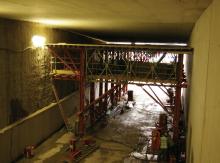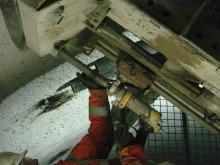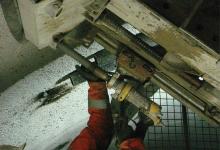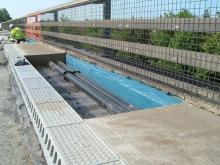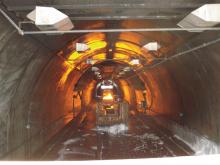The opening of a 1.8km tunnel in southern England is designed to ease traffic bottlenecks in an environmentally sensitive area. Patrick Smith reports
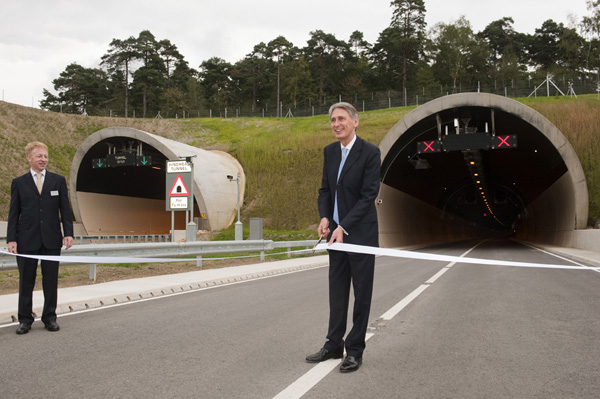
Transport Secretary Phillip Hammond cuts the ribbon to open the tunnel
The opening of a 1.8km tunnel in southern England is designed to ease traffic bottlenecks in an environmentally sensitive area. Patrick Smith reports
A tunnel under the Devil's Punchbowl in County Surrey, southern England, has been opened after a four-and-ahalf year construction project. The £371 million (US$608 million) 'missing link' twin-bore, two-lane tunnel is a state-ofthe- art structure with the latest in safety technology, and it is a conservation triumph.At 1.8km, it is the longest UK mainland tunnel, and is part of a 6.6km bypass of the Surrey village of Hindhead.
In July, Transport Secretary Philip Hammond cut the ribbon at the tunnel on the London to Portsmouth A3 road, and work has begun to return the old A3 to nature, reuniting the Devil's Punchbowl (a site of special scientific interest) with Hindhead Common for the first time in almost 200 years.
Main contractor
BBMCE delivered the project on time and on budget, describing it as a scheme that has "surpassed expectations in almost every way." The new tunnel will reduce journey times on the main route between London and Portsmouth by around 20 minutes or more at busy periods, and seven new safe crossing points have been provided for pedestrians and cyclists.
Almost 20 years ago, LUC (
After careful analysis of the area's landscape character and the appraisal of a range of route options, LUC helped the Trust argue the case to put the road into a tunnel, helping to minimise impacts on "this outstanding landscape." After the decision was approved at Public Inquiry in 2004, LUC worked with the Trust to ensure that the proposals for improving the environment of the area were realised.
In particular these included removing the old A3 and restoring the links between the Devil's Punchbowl to the west of the old A3 and Hindhead Common to the east as well as areas of heathland and historic paths and tracks.At the ribbon-cutting ceremony, Philip Hammond said:"This cutting-edge road scheme has surpassed
expectations in almost every way, and sets a new standard for how vital infrastructure improvements can be delivered in a way that not only protects, but actually enhances the surrounding environment.
Tunnel walk
During an open day on 14 May, 2011, approximately 7,000 pedestrians were able to walk the full length of the tunnel before it opened to traffic.@At the open day, local music groups performed at the north end of the tunnel. These included the Haslemere Town Band playing The Devil's Punchbowl March which was composed for the occasion by 16-yearold band member Eric Foster.@Visitors were told that:
• 737,000m³ of earth was excavated during the tunnel's construction.
• The fuel consumption rate of the excavators was 528 gallons (2,400litres) of low-sulphur diesel per day.
• Digging the tunnel took 290,875 person-hours
• 289,460m³ of concrete were made.
• 1,399,034 person-hours were worked without an accident.
• The tunnel contains 156 miles (250km) of cable.
• The tunnel lights are twice as bright as the ones at the Old Trafford stadium [home of Manchester United Football Club]
• The tunnel has 104 CCTV cameras. The main fire tank can hold 38,000litres of water.
• 4,322 people worked on the project.
"This is another one of the missing links in Britain's trunk road network now put in place." Balfour Beatty chief operating officer, Andrew McNaughton, said: "Undertaking a project of this scale and complexity demands the full cooperation of all concerned and could not have been delivered without the team spirit and partnering ethos engendered by this early contractor involvement scheme. We are very proud of the whole team including our supply chain." BBMCE was awarded the contract to build the road following a competitive tender process in 2002, and construction work on the tunnel started in January, 2007.
It will be used by an estimated 30,000 vehicles a day running under the bowl, which is a large hollow of dry, sandy heath, to the east of Hindhead.
The Highways Agency said its safety features include the UK's first radar-based incident detection system and 100% CCTV coverage, and the project has won awards for its innovation and its safety record, and has been delivered within budget and on schedule.
Mr Hammond said traffic had been held up at the Hindhead crossroads for years, hampering the flow of goods and services and blighting the lives of people living in and around Hindhead.
"No longer. This new road will transform journeys on the A3 and will deliver a threefold return on investment for the economy," he said.
The project, managed by the Highways Agency and assisted by Atkins with BBMCE as the contractor and
Drilling success at Hindhead
BBMCE invested in sophisticated new drilling equipment specifically for the project. Three brand newuse of modern drill-and-blast techniques, minimising explosives use as well as spoil haulage from the face.
Explosives costs have risen significantly in recent years so BBCME was keen to optimise this part of the operation. Hauling blasted materials away from the face can present a major barrier to productivity and efficiency, which was why the contractor also wanted to ensure that this portion of the operation ran as planned.
The up-to-date drills also allowed Balfour Beatty to achieve an optimised tunnel route and profile, further reducing construction time and expense by cutting costly overbreak.
After a year of 24/7 excavation breakthrough was achieved some 40m below Hindhead Common (the maximum depth is 65m) on 26 February, 2009, and following this the tunnel was lined and waterproofed.
The key to success
BBMCE says sustainability, incorporating innovation, safety, environmental measures and community engagement, have been key to its success.On the environment it utilised a range of sustainable construction methods during the scheme including the reduction of the tunnel cross sections and volume of excavation and the use of unconditioned excavated materials as fill in for the road's foundations: 99.9% of the total 320,000m3 of excavation was recycled and re-used on site.
The innovative construction methods included a sprayed waterproof membrane and an improved sprayed concrete mix which was applied to the tunnel walls and face. The use of laser surveying and robotic machinery enabled tight quality control improving structural performance.
"State-of-the-art safety and communications systems, including high quality lighting and ventilation, CCTV surveillance and radio-interrupt systems to convey quick information to road users have been incorporated during the tunnel's construction.
"Comprehensive safety and evacuation systems include an innovative system of radar detection for traffic incidents with connected driver warning signage, pa and radio interrupt plus cross passages at 100m intervals to connect the tunnels and allow emergency escape. The team has celebrated a further 1 million man-hours without a reportable incident, demonstrating Balfour Beatty's commitment to achieving Zero Harm by 2012," says the company.
Another innovative addition was the inclusion of 868 Astucia hardwired bidirectional studs, which will stream light and guide motorists safely through both tunnels.
The company was also proactive in keeping local stakeholders informed throughout the scheme. It gave well over 100 presentations to more than 8,000 local stakeholders including 14 schools and 130-plus community groups.
A full-scale, live emergency exercise in the tunnel was successfully completed in mid-June, and this simulated two multi-vehicle collisions, one including a fire in the tunnel, allowing the Highways Agency and emergency services to practice their response to a major incident as well as test some of the tunnel's cutting edge safety technology.
Paul Arnold, the Highways Agency senior project manager for the A3 Hindhead major improvement scheme, said: "Safety is our top priority, and we have built some state-of-theart features into the tunnel, including the UK's first use of a radar-based incident detection system. Road users and local people should be reassured that the emergency services and tunnel personnel are well equipped to deal with a real major incident in the Hindhead Tunnel."

